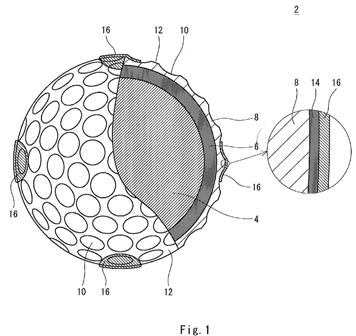Sir, Is That Your Balls I Smell?
Srixon players may be faced with that question in the future. Almost four years ago I posted about “odorant golf balls” and the impressive list of possible scents included in the associated patent application. It must be an idea that SRI has been considering as well because this week they had a patent application publish as US Pub. No. 20110190077 titled “Golf Ball,” which describes the invention as:
A ball 2 has, in a ball surface layer area, an aroma layer 16 including a scent component. The aroma layer 16 is provided locally. The aroma layer 16 may be provided on the entire surface. The scent component is preferably at least one member selected from the group consisting of terpenes, ester compounds, aromatic compounds, ether compounds, aldehyde compounds, alcohol compounds, natural essential oils, hydrocarbons, ketone compounds, lactone compounds, and nitrogen-containing compounds. A perfume-material-encapsulating microcapsule may be used. The local aroma layer 16 is preferably provided by stamping. The aroma layer may be formed by spraying. A scent adsorbent may be further used. Preferably, the golf ball 2 is put into a package 20.

The application goes on to explain how smelly balls can be exhilarating and refreshing.
[0007] A scent provided to a golf ball can positively influence a golf player. The scent can provide an exhilarating feel, a refreshing feel, a comforting feel, or the like to a golf player.
[0008] Meanwhile, a golf ball which is not white (hereinafter, also referred to as color golf ball) improves its discrimination and visibility. In addition, an appearance which is not white can provide an upscale image to a golf ball.[0009] Golf is a mental sport. The appearance and scent of a golf ball could improve a score of a golf player. In addition, the appearance and scent of the ball can influence its commercial value. The inventor of the present invention has conceived a new technical idea regarding color or scent.
[0010] An object of the present invention is to provide a golf ball having a high added value.
[0011] In a golf ball of a first aspect, an aroma layer having a scent component is provided in a ball surface layer area. The aroma layer is provided on the entire surface.
[0012] Preferably, the scent component is at least one member selected from the group consisting of terpenes, ester compounds, aromatic compounds, ether compounds, aldehyde compounds, alcohol compounds, ketone compounds, natural essential oils, hydrocarbons, lactone compounds, and nitrogen-containing compounds.
.
.
.
[0093] The scent component can provide, for example, an exhilarating feel or a refreshing feel. Examples of scents which can provide an exhilarating feel or a refreshing feel include a scent of mint (peppermint) and scents of spices (herbs). These scents can have an effect of refreshing a player and increasing the player’s concentration. Examples of scent components which provide an exhilarating feel or a refreshing feel include limonene (terpenes: scents of citrus fruits), menthol (an alcohol compound: a scent of mint), menthone (a ketone compound: a scent of mint), terpineol (an alcohol compound: a scent of lime), citral (an aldehyde compound: a scent of lemon), camphor (a ketone compound: a scent of mint), anethole (an ether compound: scents of fennel and the like), estragole (an ether compound: a scent of estragon), 1,8-cineol (an ether compound: scents of eucalyptus, sage, and laurel), eugenol (an alcohol compound: scents of clove, pimento, and the like), cummin aldehyde (an aldehyde compound: a scent of cummin), cinnamyl aldehyde (an aldehyde compound: a scent of cinnamon), and a natural essential oil having a scent of pepper mint.[0094] In addition, the scent component can provide, for example, a comforting feel. Examples of scents which provide a comforting feel include scents of fruits and scents of flowers. These scents can have an effect of calming one’s feeling when feeling excited or pressed. Examples of scent components which provide a comforting feel include cucumber alcohol (an alcohol compound: scents of melon and watermelon), aldehyde C-8 (an aldehyde compound: a scent of orange), cucumber aldehyde (an aldehyde compound: scents of melon and watermelon), vanillin (an aldehyde compound: a scent of vanilla), nootkatone (a ketone compound: a scent of grapefruit), raspberry ketone (a ketone compound: a scent of raspberry), ethyl caprate (an ester compound: scents of rum and brandy), allyl caproate (an ester compound: a scent of pineapple), isoamyl acetate (an ester compound: a scent of banana), ethyl acetate (an ester compound: scents of melon and grape), styrallyl acetate (an ester compound: a scent of grapefruit), hexyl acetate (an ester compound: scents of apple and pear), ethyl butyrate (an ester compound: a scent of pineapple), coconut aldehyde (a lactone compound: a scent of coconut), peach aldehyde (a lactone compound: a scent of peach), methyl anthranilate (a nitrogen-containing compound: a scent of grape), rose oxide (an ether compound: a scent of rose), geraniol (an alcohol compound: a scent of geranium), linalool (an alcohol compound: a scent of lavender), .beta.-phenethyl alcohol (an alcohol compound: a scent of rose), cyclamen aldehyde (an aldehyde compound: a scent of lily of the valley), .alpha.-ionone (a ketone compound: a scent of violet), cis-jasmone (a ketone compound: a scent of jasmine), benzyl acetate (an ester compound: a scent of jasmine), and furaneol (a ketone compound: a scent of strawberry).
So, do you think a scented ball would improve your scores? I doubt it but just in case…. sign me up for a few dozen in the pineapple scent!
David Dawsey – Keeping an Eye on Golf Ball Technology
PS – click HERE to read more interesting golf ball patent posts
